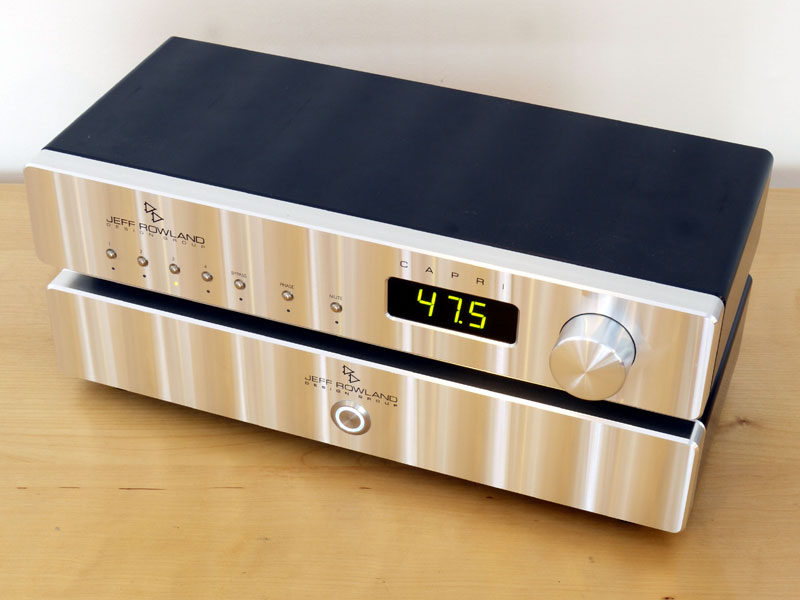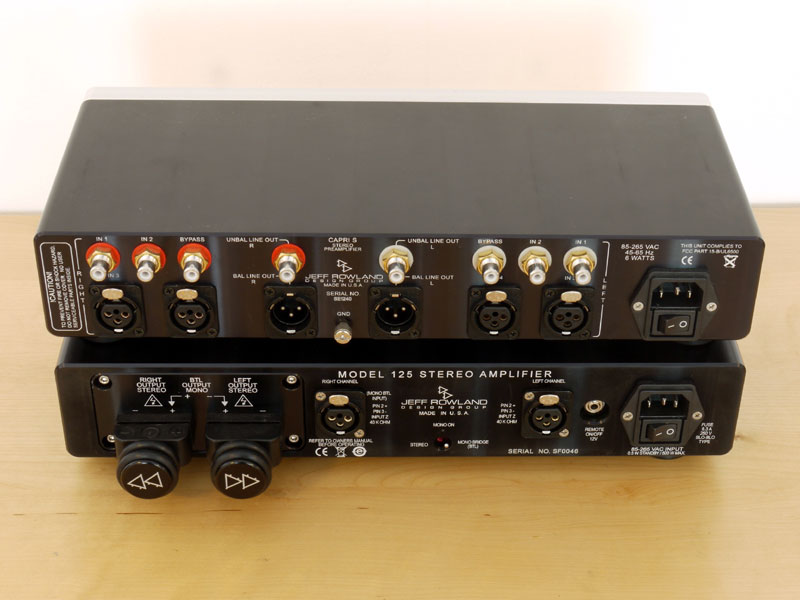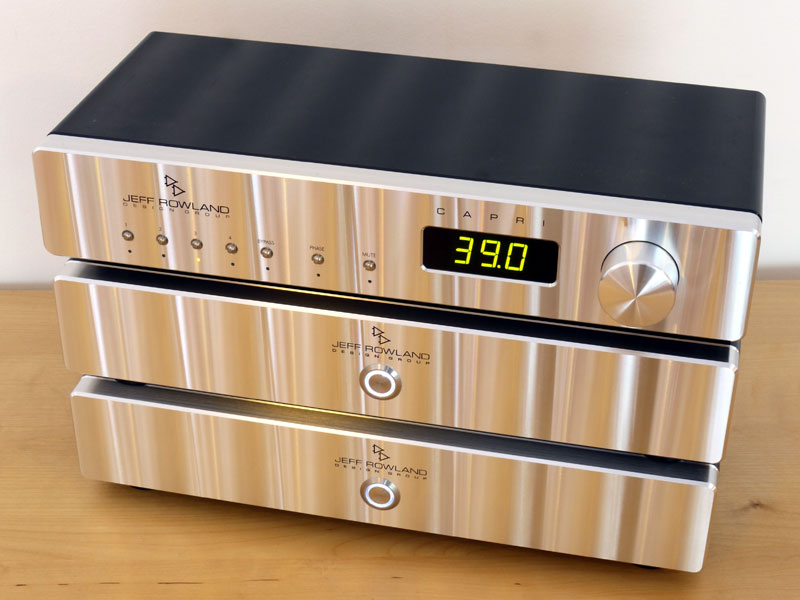First Sounds: Jeff Rowland Design Group Capri S2 and Model 125
hen your house is accommodating no fewer than eight plus-sized, high-powered tube amplifiers, it’s hard to escape the conclusion that audio equipment is getting bigger, hotter and a lot more expensive. With what passes for summer in the UK threatening a spell of moderately warm weather, thermal output is becoming a serious consideration, while the physical imposition of all that metalwork -- not to mention the multiple preamp chassis that go with it -- is adding significantly to my daily mileage as I repeatedly circumnavigate it. So what would you say to the proposition of a svelte, cool-running preamp/power amp package that delivers 125Wpc into 8 ohms and 250 into 4 ohms, from casework that’s smaller than the box for a pair of Converse sneakers -- and not even high-tops at that. Now, throw in a big-bucks brand name, top-shelf fit, finish and styling, fully complementary circuitry, the availability of internal DAC or MM/MC phono cards for the preamp, and the ability to bridge the stereo power amp to deliver 500 watts into 8 ohms. Okay, so no prizes for guessing that we’re talking class-D amplification here, or that the brand in question is Jeff Rowland Design Group. But that latter point is kind of crucial, because not only does Rowland consistently turn out some of the prettiest and most elegantly styled products on the market, they have been doing class D for a while, and have been for quite some time about the only company to produce genuine high-end performance from the technology. It’s no coincidence that Marc Mickelson gave the ambitious and powerful twin-chassis Model 825 his vote for product of the year last time out -- or that the 825 and 925 class-D designs sit atop a range that also includes the Model 625 and 725 class-AB designs. But it’s at the other end of the range that you’ll find the subjects of this article, the impossibly small Capri S2 preamp ($3950, including standard MM/MC card) and Model 125 stereo power amp ($2950). I say "impossibly" because despite their semi-standard, midi width of 13.7" and 2.7" height, each chassis is only 6" deep. Believe me, the first time you see one of these units you’ll think it’s a lot less than that, so shallow is the footprint that it seems almost alien.
Despite these diminutive dimensions, the Capri S2 is a genuine full-facilities line-stage preamplifier that shares both the looks and operational niceties of the higher-zoot Rowland products. It offers two sets of balanced and two sets of single-ended inputs (one of which can be converted using internal cards into either a phono or digital input), and you also get a set of theatre-bypass inputs and both balanced and single-ended outputs, one set of each. There are crisply latched front-panel buttons for input selection, absolute phase and mute, while the rotary volume control is hooked up to an LED display large enough to let you get a clear numerical appreciation of level from the other end of a decent-sized ballroom, let alone the average listening seat. The small handheld remote duplicates the front-panel controls and allows you to switch the display on or off -- the Capri S2 sounds better when the display is off -- as well as adjust balance. The Model 125 is even more straightforward: one set of balanced inputs, two Cardas dual binding posts and that’s your lot, apart from the same soft-touch, circular power switch on the front panel, complete with blue circumference illumination that graces all of Rowland’s other power amps. Just like those bigger brothers, the 125 is silent on startup and silent in operation. No relays clunking or inrush thumps or buzzes. Press the button, it glows softly and you are ready to go. That switch isn’t the only visual link to the rest of the Rowland line, and in terms of aesthetics and construction, you’d be hard-pressed to tell the Capri S2 or 125 from any other of the other units in the range, irrespective of price: same beautifully finished front panel, same matching top plate, same rounded casework and same hidden fixing. Bearing in mind that the line tops out around $60,000 for a pair of 925 monoblocks, that’s pretty darned impressive given the price of these units and Rowland’s stellar reputation for the quality of its casework. In fact, the Capri S2 and 125 chassis are machined in exactly the same facility as the other Rowland products. Look really closely and you’ll see that in fact, rather than a separate front panel, the 125 chassis is actually machined from a single piece, the bare metal pared back after the main body has been anodized. It’s the only cost-saving measure in evidence and one that frankly, unless somebody pointed it out, you’d likely never notice.
Remove the recessed bottom plates and you’ll see that the real-Rowland ethos continues on the inside. The PC boards are beautifully laid out and neatly installed in pocketed sections cut into the monocoque chassis. Want to install a DAC or phono stage? It’s a five-minute job and should be well within the capabilities of any end user. The result is a superbly executed and remarkably capable package whose dimensions belie its performance.
h, yes, the performance. Isn’t this just another class-D amp dressed up in fancier clothes? As I mentioned earlier, Rowland have been doing the class-D thing longer and considerably better than most, to the extent that you can actually forget the fact that this amp is class D. Instead, ask yourself how it sounds in absolute terms -- and how that stacks up against the price. The answer might well surprise you: it certainly surprised me. In absolute terms it’s not hard to find flaws in the Capri S2/125 combination -- or anything else at or near this price, a point it’s easy to overlook. In this case, those flaws are not unusual for a solid-state design at this kind of cost. The soundstage has plenty of width but lacks some depth. Tonality is essentially neutral, with a slight leanness through the upper midrange that adds a sense of space and air to recordings. Be aware that when cold there’s a shiny glaze across the range that robs instruments of character and congeals the soundstage, but then one beauty of efficient circuits like these is that they can be left on and that will dissipate across the first day or so, the sound gaining color and instruments identity as the electronics warm through. Once warm, the solid casework helps them stay that way and the amp is remarkable consistent thereafter. Finally, dynamics lean more to the progressive than the sudden -- which may well be a class-D artifact -- so that the burgeoning swell of an orchestra is mightily impressive, but the cannonade of a drum fill behind a rock recording somewhat less so. However, as I said, these failings are on a par with the competition and far from fatal. So, that’s what the Rowlands don’t do; time now to look at their strengths, which are considerable. The first thing you’ll notice about these electronics is their uncluttered sense of stability and calm. They never, ever sound edgy or frenetic, retaining their sense of balance and poise, the soundstage its sense of planted location, whatever the musical demands. There’s also an almost organic coherence to their sound, as if it grows from the inside out, rather than you looking from the outside in. It’s a quality that these separates have in common with the company’s Continuum S2 integrated, a unit that I described as having an almost cinematic quality, the way the performance unrolled so effortlessly before me. The Capri S2 and 125 have that same sense of smooth, easy flow, a listenable quality that seems to invisibly underpin your listening. I’ve already talked about the way they allow orchestral music to swell and grow, the Barbirolli/RPO Sibelius 2nd Symphony [Chesky Records CD-3] being perhaps the perfect example, the gradual ramping of the orchestral parts to slowly create those monumental, towering crescendos playing perfectly to the 125’s power delivery, especially if you add the second amp and run them bridged. But these amps are just as impressive on anthemic rock. Echo’s 1997 Evergreen [London 828 980-2] has to be one of the greatest comebacks since Lazarus. Just play "Forgiven" to hear why, its gentle, sparse opening gradually building into music of truly architectural substance and scale, a genuine musical tour de force. The Rowlands scale the peaks, building them bigger and ever higher, before gracefully transitioning back to the small, intimate finale. Now, go to the opposite extreme and listen to something small and acoustic; how about the beautiful harmonies of "One Day I’ll Fly Away" (Gillian Welch and Alison Krauss, Down From The Mountain [Lost Highway 088 170 221-2])? You’ll immediately notice their uncluttered sense of organization and just how easily you can separate and recognize the individual voices. You’ll also notice that the mandolin actually sounds like a mandolin, where many systems make it sound more like a banjo. This sense of tonal separation and identity is testimony to the electronics’ lack of additive masking, the upside of that subtle upper-midrange leanness. Add that to the power, scale and stability I’ve already described and what you have is a setup that favors musical coherence and content, shape, scale and structure over immediacy, presence and dimensionality. There’s a contained sense of organic connection between the musicians and the musical strands that emerges from the 125, a sorted clarity and organization, an unforced, easy elegance. It makes the Capri S2/125 combination a versatile all-rounder, equally at home with all musical genres. Of course, talking of versatility brings me to the subject of the internal DAC and phono options. These make the Capri S2 potentially even more attractive, but before we get too carried away, let’s just clarify exactly what’s on offer, starting with the internal DAC. The Capri S2 is priced at $4400 if you opt for the DAC in place of the phono card. This is unquestionably a cost-effective way of adding digital decoding to a Capri S2/125 setup, and the performance of the DAC is very impressive in a quick, clean, explicit style that’s big on presence, immediacy and timing. It brings a lovely sense of pace and flow to music, relaxed when it should be, urgent when it needs to be. It stands comparison with the digital stages in CD players up to the $10,000 mark, which is no mean feat. Compare it to the DAC in a moderately priced player and it will be no contest. Hook it up to a good budget transport (Rega or Heed spring to mind) and you’ll have excellent CD replay. Hook it up to a CEC TL-3N and you’ll have a genuine giant killer. But -- and these days it’s a very big but -- it limits you to a single S/PDIF RCA input, which, given the plethora of available digital devices and connection options (particularly USB), is definitely less than ideal. It also costs you one of your two single-ended analog connections, input 1 becoming the digital input. There’s no arguing with the value and sound quality on offer, but whether or not you can take advantage of it will be down to your system configuration and the number and type of digital sources you want to run. If you stick with the standard phono stage, it too is connected to input 1, a pair of compact boards mounting just inside the rear panel, IC-based and offering jumper-switchable gain and loading (60db of gain with either 100- or 400-ohm loading, 40 or 50dB of gain with 47k-ohm loading). Don’t be fooled by the diminutive size of the cards. Careful layout and the use of precision SMT components mean that they may be smaller than a matchbook but they provide comprehensive gain and RIAA EQ circuitry. This phono stage is exceptionally good, ghostly quiet with a warm, solid character that complements the Capri S2/125 signature perfectly. Loading options may be limited, but this is way more than a stopgap solution and you’ll be looking at many times the asking price to get a standalone unit that significantly betters it. Which introduces the subject of the new HP phono cards (which raise the price of the Capri S2 to $5000), a recent addition to the range of options offering another step up in performance. They use a pair of high-quality Lundahl MC step-up transformers and provide adjustable loading in 14 discrete steps between 60 and 1026 ohms, via the smallest bank of DIP switches I’ve ever seen. I haven’t had a chance to give it a proper work out, so value and performance judgments must wait, but be aware that the Capri S2 has more than one trick up its sleeve.
he Capri S2/Model 125 combination is one of the neatest, most versatile and most tractable product combinations I’ve ever had in-house. It ticks most boxes, is compact, portable and unfussy and draws surprisingly little musical attention to itself. While it has been here it has found itself called into action in a whole range of ridiculously demanding systems and always acquitted itself brilliantly, the ultimate emergency cover or placeholder. But you don’t begin to appreciate just how quietly competent and musically expressive these products are until you leave them in a settled system and simply enjoy what they do -- and do and do. They just get on with the job without intruding or showing off. Eventually, you come to take them out -- which is when you realize just how effective they really are. Budget esoterica and small
but perfectly formed express common sentiments about audio equipment, yet no two
phrases better encapsulate exactly what these Jeff Rowland products represent. Bijou
in the truest sense of the word, they might seem expensive at first glance or first
listen, but once you understand their musical capabilities and sheer versatility, their
growth potential and ability to accommodate upgrades around them, you’ll appreciate
their long-term appeal. The 125 in particular constitutes a model of modular flexibility,
with the option to add a second amp and the ability to partner with even exotic
front-ends, DACs and preamps. The shifting digital landscape is crying out for a Capri
S2-sized DAC that's even more capable, has more inputs and quite possibly a variable
output, but even without that option, the existing Capri S2 and Model 125 represent a
serious option for serious music lovers. Small boxes with big musical hearts, they’ll
bear comparison with anything at or near their asking price -- and look way prettier while
doing it. |



